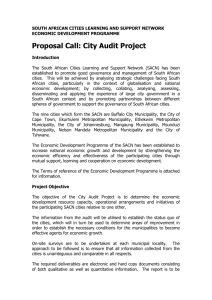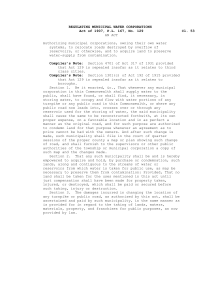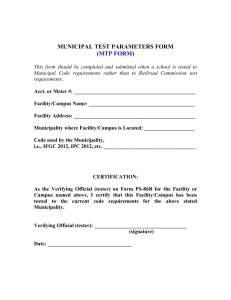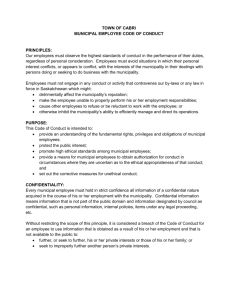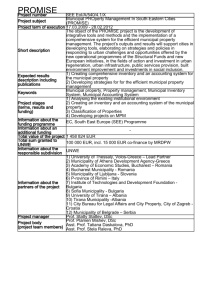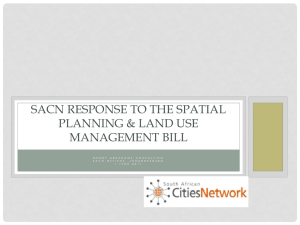PowerPoint Presentation - South African Cities Network
advertisement
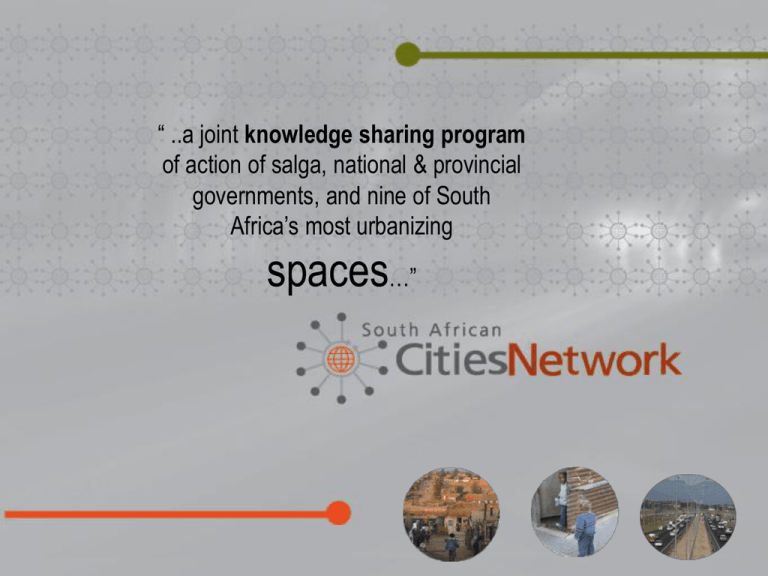
“ ..a joint knowledge sharing program of action of salga, national & provincial governments, and nine of South Africa’s most urbanizing Cover page spaces…” Issues Covered In Presentation 1. Organisational Mandate 2. How has the SACN performed since establishment? 3. What are the “new” challenges facing the local government sector and SACN member municipalities? 4. How should SACN be responding? 5. Issues to look out for 6. What are the Business Implications Since its inception in 2001/2, the SACN has been a network of the nine largest municipalities in the country rather than a representative structure, whose objective is to: ∇ Promote good governance and management in South African cities; ∇ Analyse strategic challenges facing South African cities; ∇ Collect, collate, analyse, assess, disseminate and apply the experience of large city government in a South African context; and ∇ Promote shared learning partnerships between the different spheres of government to support the management of South African cities. Membership & Governance Board is comprised of: • COGTA, DOT, DHS, SALGA, Buffalo City Municipality, City Of Cape Town, Ekurhuleni Metropolitan Municipality, City of eThekwini(Durban), City of Johannesburg, Mangaung Municipality, Msunduzi Municipality, Nelson Mandela Bay Municipality and the City Of Tshwane (Pretoria) Our Programmatic Approach is derived from the Local Government White Paper and thus a analytical tool for continuous municipal performance evaluation Productive City Inclusive City • Can the local economy provide the majority of residents with opportunities to make a reasonable living? • Do residents have the opportunities and capacities to share equitably in the social and economic benefits of city life? City Development Strategy What are the immediate, medium and long term growth and development imperatives of the municipal area? Well Governed City Sustainable City • Is the political and institutional content stable, open and dynamic enough to accommodate varied objectives and interests? • How is the city impacting on the limited reserve of non-renewable resources that sustains the settlement and makes it viable? Firstly, the major shift in terms of the 2011-2016 focus of the SACN is its understanding of member city typology and thus the programmatic scope. Secondly, the business framework suggests that consideration needs to be given to broadening the programmatic reach to non-traditional SACN member cities, including SADC . Thirdly, it proposes that, in order to become more effective, attention and focus needs to bias itself on changing policy response and practitioner behavior across the spheres of government by deepening knowledge sharing. giving effect to differentiated approach What is happening globally ? • Cities worldwide are taking center stage in the sustainable development and prosperity of nations. • Cities contribute 70 percent of the world’s GDP -- of the world’s 100 largest economies, 37 are cities, outranking many large multinational corporations, such as British Petroleum and Exxon Mobil, as well as economies of large countries such as Australia and Argentina. • Urbanization is a defining phenomenon of the 21st century. Countries have moved through similar, and rapid, transitions, including Brazil now at 86% urban, the United States (82%), Australia (89%), United Kingdom (90%), and Jordan (78%). Selected global city-regions, urban corridors and mega-regions UN HABITAT, State of the World’s Cities 2010/ 2011: Bridging The Urban Divide Some Key Research Agenda Issues for Local Government Sector in the next decade WORSTREAM I: Acting with a Better Understanding 1. 2. Adopt urban development policy regime that seeks to strengthen productive and sustainable urban spaces Provide local government indicators that allows better governance & interpretation at varied scales (e.g. ward, region, municipal, city region) WORKSTREAM II: Changing Built Environment Function 3. 4. 5. Addressing issues of land and land-use management Increasing city efficiencies by improving Public Transport Using Human Settlements to create social cohesion WORKSTREAM III: Unhesitant in Dealing with Vulnerability 6. Understanding better and improving local government financing model 7. Managing better and impacting positively on a vulnerable natural resource base 8. Better understanding of and enhancing rural/urban inter-dependence & interface 9. Building and dedicated & focused human capacity for local government 10. Promoting socio-political stability
